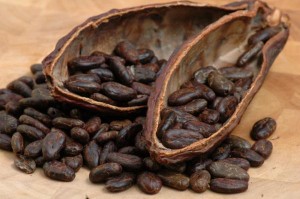 Cocoa kept on advancing on Friday, marking a fourth straight day of gains. The beans that are used for chocolate production surged more than 5% so far this week as unfavorable weather conditions in the main growing regions is fueling speculations the next harvest, second for the year, will be delayed.
Cocoa kept on advancing on Friday, marking a fourth straight day of gains. The beans that are used for chocolate production surged more than 5% so far this week as unfavorable weather conditions in the main growing regions is fueling speculations the next harvest, second for the year, will be delayed.
On the NYSE LIFFE, cocoa futures for July delivery traded at 1 517 pounds per ton at 12:33 GMT, up 0.53% on the day. Prices ranged between days high of 1 525 and low at 1 510 pounds, the opening price. Cocoa has marked daily gains throughout the week except on Monday and has advanced 5.2% so far after settling 1.48% higher last week.
According to the International Cocoa Organization, farmers in Ivory Coast are harvesting the third highest cocoa mid-crop ever. This is the first and smaller of two annual harvests with the second one called main-crop. Lack of rain in Ivory Coast and Ghana are spurring concern the main-crop will be delayed. According to Kevin Marcus, founder of the commodity weather consulting company Marcus Weather in Passaic, New Jersey, a large mid-crop slows the development of the main-crop as the tree suppresses its early setting, hindering the development of pods.
Olivier Abeyao, a farmer in eastern Ivory Coast, said for Bloomberg: “It hasnt rained for about 20 days which is unusual for the season. The main harvest may be delayed if the rain doesnt fall by mid-July.”
Gilles Bledou, head of a farming cooperative in Aboisso, in southern Ivory Coast said: “It has rained only three days in June while it should be raining hard in this season. If theres not enough rain, the output will be down and the harvest will be delayed. Were not in a critical situation yet, but we hope it will rain more in July.”
Sugar gains
Meanwhile, sugar gained as millers in Brazil are expected to use more cane for biofuel production instead of the sweetener. Sugar for October delivery stood at $0.1645 at 11:05 GMT, varying between days high and low at $0.1646 and $0.1638 a pound respectively.
Unusual for dry the season rain disrupted the crops potential to yield sugar. Plinio Nastari, president of the Barueri, Brazil-based researcher, said millers will use 47% of the gathered cane to produce sugar in the 2013-2014 season, 2% less than last years 49%. He commented: “The fact that it rained a lot at the end of May and in June is increasing the prospects that the mix will favor more ethanol than previously forecast. When it rains, the sucrose that was in the mature cane goes back to being glucose and fructose and you can’t crystalize as much as you want and millers are therefore forced to turn these sugars into ethanol.”
Brazil is expected to export 4.1 billion liters of ethanol to the U.S. between 2013 and 2014, up from last years 3.03 billion liters, according to Datargo, the largest consultancy of ethanol and sugar in Brazil and one of the largest in the world.
Arabica gains
Meanwhile on the ICE Futures Exchange, arabica for September delivery traded at $1.2195 a pound, up on the day. Prices ranged between days high and low of $1.2263 and $1.2165 respectively. The C contract advanced 1.3% throughout the week after settling 0.88% higher the preceding one. Arabica lost more than 2% on Tuesday as the cheaper Brazilian currency gave growers a competitive advantage on the markets, which spurred sales. Growers in Brazil are unloading beans in order to clear storage for the next harvest. The real dropped 9.4% during the second quarter, the most among 24 emerging-market countries, causing the world’s biggest producer to sell more on account of Peru. Peru, the third biggest South America arabica grower, sold 31% less coffee during the first five months of the year as buyers switched to Brazil due to its cheaper currency. Colombia, the second biggest arabica grower, increased its export by 32% as the peso fell 7.1% against the U.S. dollar.
On the NYSE LIFFE, robusta September futures remained fairly unchanged on the day, trading at $1 818 a ton, down 0.05%. Prices ranged between days high and low of $1 826 and $1 815 respectively. Robusta rose to the highest in three weeks on Tuesday amid speculation prices fell last quarter too much, while stockpiles in Europe declined and premiums in growing countries were high. The sort that is mainly grown in Vietnam fell 14% between April and June, which is the worst quarter since Q3 2011. Meanwhile, stockpiles, monitored by the NYSE LIFFE, fell by 1.3% in the two weeks to June 24.





